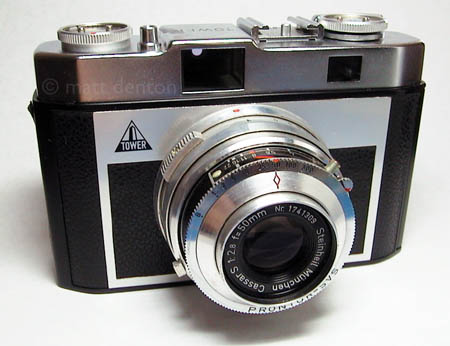- Produced late 1950s by Kamerawerke Wilhelm Witt, Hamburg, Germany
- Film type 135 (35mm)
- Picture size 24 x 36mm
- Weight
- Lens Steinheil Munchen Cassar 50mm 1:2.8
- Filter Size accepts Kodak Series VI adapter no. 26
- Focal range 3′ to infinity
- Shutter Prontor-SVS
- Shutter speeds B, 1-1/300
- Viewfinder coupled rangefinder
- Exposure meter none
- Cold shoe, PC sync
Overview
This stylish little rangefinder was made in Germany for Sears by Kamerawerke Wilhelm Witt, probably more famous for its Iloca Rapid stereo camera than this more mainstream shooter. The 1958 Sears camera catalog says of the Tower 51 “if there’s a better camera at this price – we’ve never seen it. If there’s one easer to use – at this price – we don’t know of it.” The price in 1958: $56.50, or $65 with case and folding bulb flash. Similarly featured cameras were selling at the time for upwards of $75. It does seem to be fairly competitive in its features in its class at the time, especially for a German import; the only better deals at the time were from Ansco (Memar) and Argus (c-four).
From what I can tell, this model differs from the Iloca Rapid B only by the instruction manual printed on the bottom plate cover. Where the Iloca has a leatherette bottom cover and a “Made in Germany” stamp on the rewind button, the Tower 51 has all the camera’s basic instructions printed on the metal bottom coverlet and has “Hold in while rewinding film” printed on the rewind button. Very helpful!

Back in the day, Sears ran their camera division almost as a subisdary, aimed at building relationships with photographers and hoping to be a one-stop-shop for budding amateurs through serious amateurs and semi-professional photographers. They sold budget and high-end cameras, from Kodak to Leica and had many different OEMs building cameras and equipment to be sold under their own Tower name, often of very high quality for the price. Sometimes with minor modifications like you see here with the printed instructions to help their target audience take better pictures and feel better about continuing their relationship with Sears.
Repairs
It was in great shape actually, apart from cloudy rangefinder glass. I found some great instructions for disassembling the Iloca Rapid which allowed me to get in the top and clean it up. It was extremely easy to do, the snap rings that hold down the knob covers were the easiest I’ve ever removed. I made sure not to use any liquid on the beamsplitter (colored glass), but gently brushed the dust off with a Q-tip.
Tips & Tricks
To open/remove the camera back you pull up on the film reminder wheel to its limit, then turn clockwise and the side opens to let the back off. To close just pop the back into place right side first. Loading film is fairly straightforward, put the canister in the left and the leader in the slit in the takeup spool, wind on to get the film wound in the takeup spool, making sure the film counter teeth are engaged in the sprocket holes, and put the back on. The geared frame counter is manually set by turning counterclockwise to 0.
PC port and cold shoe, don’t forget to set the MXV switch to X for instant photo and electronic flash (V is self timer, M is for bulbs).
Related Links
- Karen Nakamura’s Iloca Rapid B page
- Daniel Mitchell shows how to take one apart!
